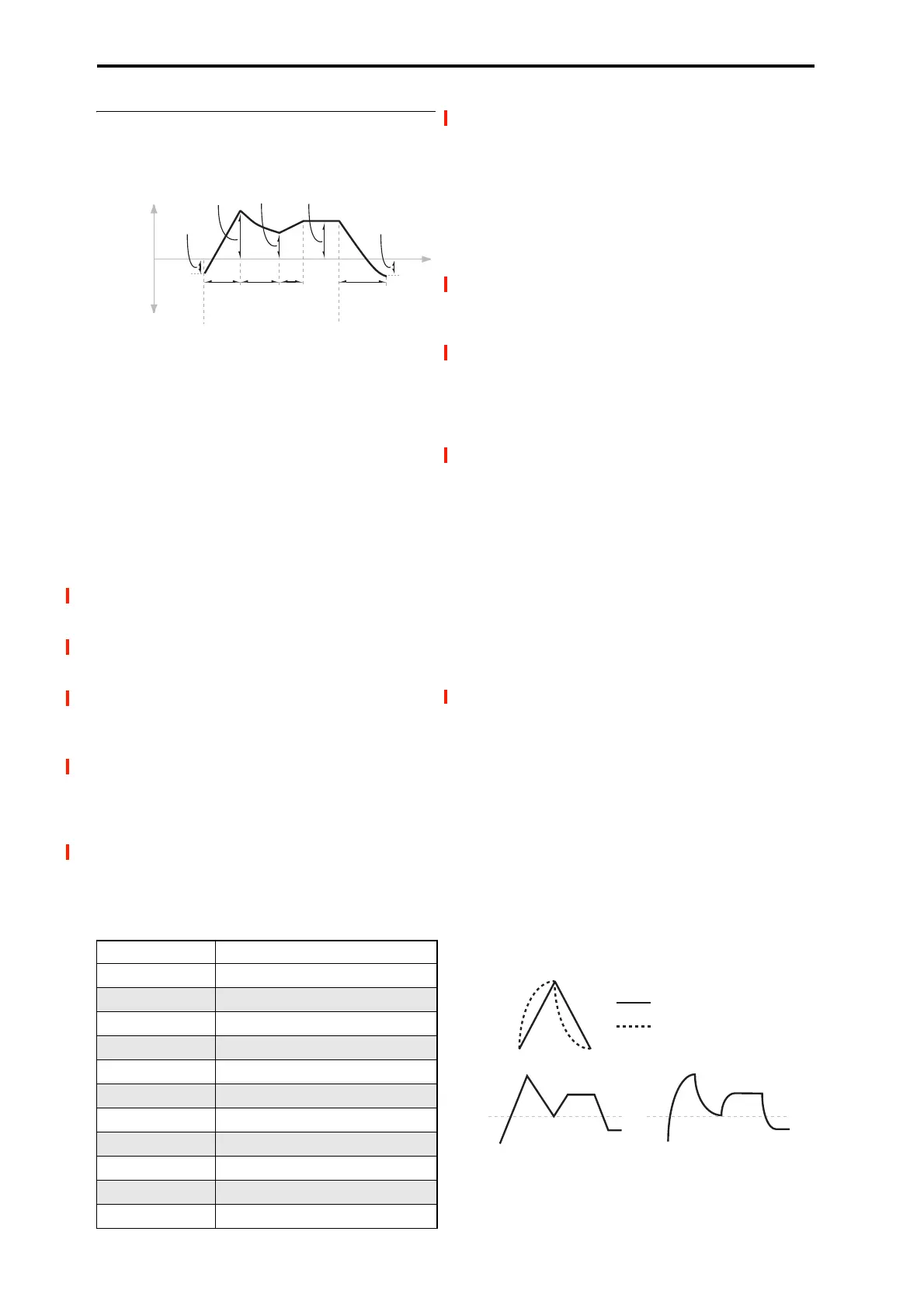EXi: AL-1 Analog Synthesizer
170
7–1b: Envelope
EG
Envelopes create a modulation signal by moving from one
level to another over a specified time, and then moving to
another level over another period of time, and so on.
The parameters below let you set five levels, the amount of
time it takes to go from each of the levels to the next, and the
shape (from linear to curved) of each transition.
Level
Each of the five levels can be either positive or negative.
Positive levels will make the cutoff frequency (or other
AMS destination) go up from its programmed value;
negative levels will make it go down.
Start [–99…+99]
This sets the initial EG level, at note-on.
Attack [–99…+99]
This sets the level at the end of the Attack time.
Break [–99…+99]
Break, short for Break Point, sets the level at the end of the
Decay time.
Sustain [–99…+99]
This sets the level at the end of the Slope time. Once it
reaches the Sustain level, the EG will stay there until note-
off, unless it is reset via AMS.
Release [–99…+99]
This sets the level at the end of the Release time.
Time
Higher values mean longer times, as shown below:
Attack [00…99]
This sets how long the EG takes to move from the Start level
to the Attack level.
The minimum attack time is 2/3 of a millisecond–as fast as
the most punchy of classic analog synths.
For the fastest possible attack time, you can set the Start
level to +99; in this case, the EG will start instantaneously at
its maximum value.
Decay [00…99]
This sets the time it takes to move from the Attack level to
the Break level.
Slope [00…99]
This sets how long the EG takes to move from the Break
level to the Sustain level. Once it reaches the Sustain level,
the EG will stay there until note-off (unless it is reset via
AMS).
Release [00…99]
This sets how long it takes the EG to move from the Sustain
level to the Release level.
Curve
For the sake of simplicity, most of the diagrams in this
manual show envelopes as being made out of straight lines.
In actuality, though, envelopes are more likely to be made
out of curves.
In other words, each segment’s level will change quickly at
first, and then slow down as it approaches the next point.
This tends to sound better than straight, linear segments.
Classic analog synth envelopes made these curved shapes
naturally. The NAUTILUS goes a step further than vintage
synths, however, and lets you control the amount of
curvature separately for each of the four envelope segments.
When you change the curvature, the EG times remain the
same. However, greater curvature will tend to sound faster,
because the value changes more quickly at the beginning.
Different curve settings for up and down
You may find that different amounts of curvature are suitable
for segments which go up and segments which go down.
For instance, a curve of 3 is a good default setting for
upward segments, such as Attack. On the other hand, a curve
of 6 or more is good for downward segments, such as Decay
and Release.
EG Curve
EG Value Actual Time
00 0.667 ms
10 10 ms
20 44 ms
30 104 ms
40 224 ms
50 464 ms
60 944 ms
70 1.8 seconds
80 3.8 seconds
90 10.9 seconds
99 87.3 seconds
Note-on or reset Note-off
Attack
Time
Start
Level
Decay
Time
Release
Time
Release
Level
Attack
Level
Change to
Parameter
Value
Sustain
Level
Time
Break
Level
Slope
Time
Curve = 0 (Linear)
Curve = 0 (Linear)
Curve = 10 (Exp/Log)
Curve = 10 (Exp/Log)

